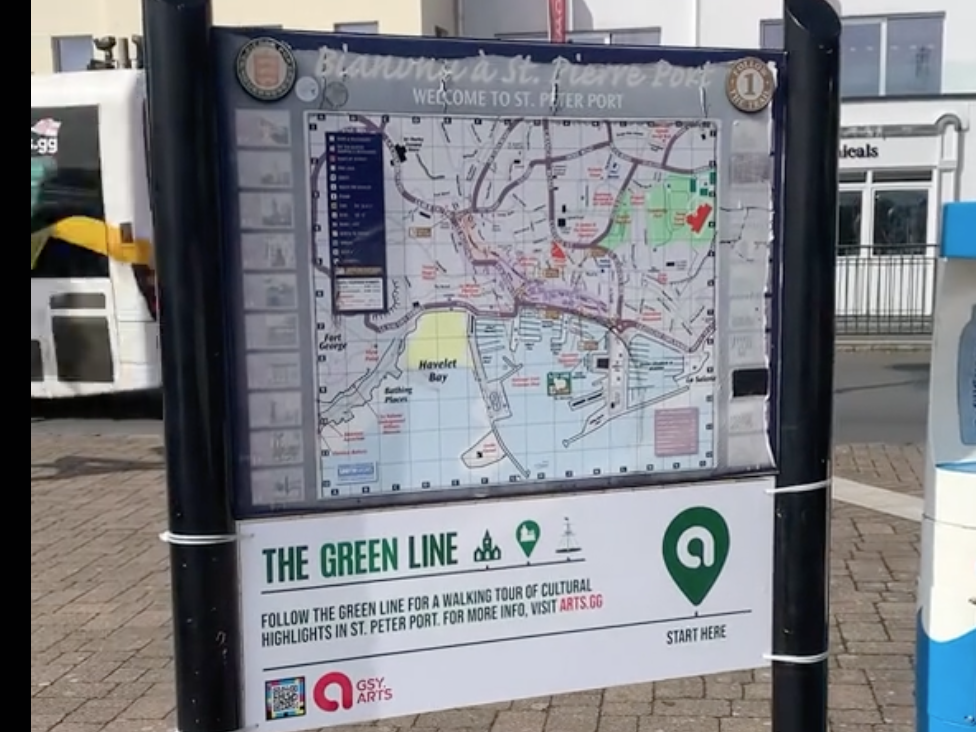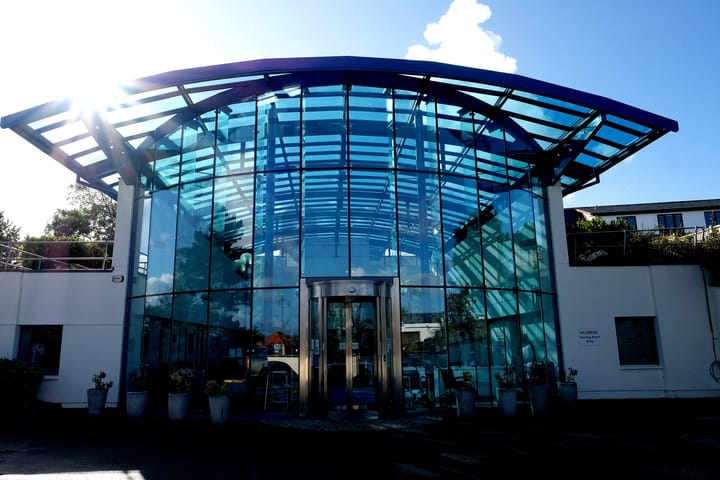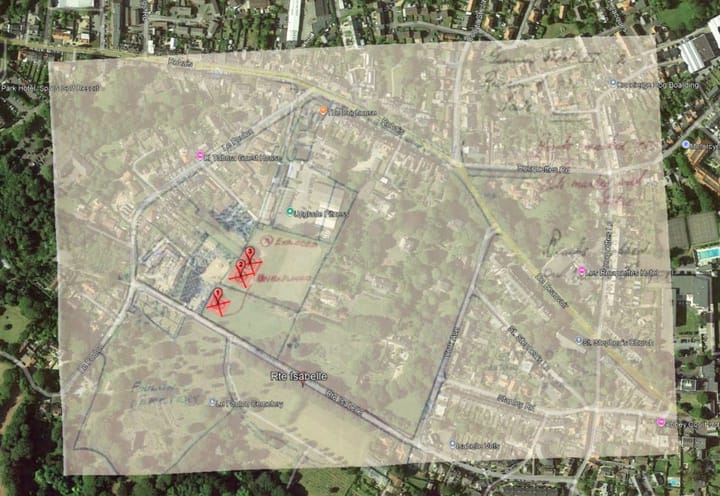WATCH: A guide to the Green Line and St Peter Port's highlights

- Guernsey Arts is launching a Green Line to guide visitors through St Peter Port.
- The project will highlight cultural features often overlooked.
- The initial route runs from the Liberation Monument to Town Church.
- Feedback will be collected through an online form until December.
- The initiative draws inspiration from Nantes' successful Green Line project.
Guernsey Arts has installed a Green Line through the heart of town, aiming to create a self-guided walking tour that showcases the historic and cultural highlights of the area.
The Green Line, marked by a green stripe on the pavements, will facilitate exploration by both visitors and locals.
Click to read about the hidden gems the line takes you to
The Green Line begins near the Liberation Monument, created in 1995 to mark the 50th anniversary of Guernsey’s liberation.
Designed by local artist Eric Snell and astronomer David Le Conte, the monument is an obelisk sundial made of 50 layers of granite, each layer representing a year since liberation.
The cut angle at the top symbolizes the trauma of the German occupation. Each year on 9th May, the obelisk’s shadow points to inscriptions commemorating key events of that day.
Nearby, you’ll find several memorial plaques including:
● Deportees Plaque
This remembers over 1,000 people deported from Guernsey and Sark during WWII.
● Evacuees Plaque
This commemorates those evacuated in June 1940 prior to the German invasion.
● Jewish Women’s Memorial
This memorial is dedicated to the three Jewish women who were deported from Guernsey to their deaths at Auschwitz-Birkenau in 1942.
● Titanic Memorial
This memorial records the names of Guernsey Residents who perished when the Titanic sank in 1912. The plaque has 14 sides to represent each individual who died.
● Liberation Stones
These stones mark the 60th and 70th anniversaries of Liberation and were unveiled by Queen Elizabeth II and the Countess of Wessex respectively.
Additional memorials nearby honour the Resistance, Harbour Bombing, and foreign workers. An information board in the area lists all memorials and their locations.
From here, you can also view the Memorial Mast, a 100ft (30m) structure inspired by the mizzenmast of HMS Orion, commanded by local maritime hero Admiral Lord James Saumarez at the Battle of the Nile. It commemorates the 60th anniversary of Liberation Day and is often used to fly flags for special island events.
Follow the Green Line to the traffic lights. When signalled to, cross the road and turn left, heading south along the Esplanade. On your right you’ll see a granite water fountain dated 1861, originally supplied by a cistern on Havelet Road. A similar fountain once stood near the Town Church.
Further along is a striking granite building, formerly an island administrative centre, information centre and post office. Plans are underway to transform it into the Victor Hugo Centre.
Outside is a statue titled "Yesterday, Today, Tomorrow" which was sculpted by local artist Mark Cook to commemorate the 70th anniversary of Liberation.
It depicts a family of four in 1940s dress. The figures hold hands, with outstretched arms at each end, inviting you to become part of the artwork.
Continue along the Esplanade and turn right up the Pier Steps. For a step free route, go back to the Thomas De La Rue pub and follow the road around.
The line takes you up the steps and then turns left down the High Street, a pedestrian area. At the top of the steps, turn left into the pedestrianised High Street, lined with grand granite buildings that were once merchant homes.
In the 18th century, merchants moved to the suburbs as the town grew busier with the tobacco and rum trades. If you look carefully at the houses, you may see hidden symbols in the granite which hint at what the Merchant used to sell.
On your left, you’ll see a bust of Daniel de Lisle Brock, a former Bailiff of Guernsey. Look up nearby to spot a brick outline of Guernsey on a stone gable.
Continue down the High Street and cross the road to reach the Town Church. The earliest known religious building on this site was in 1020, with reference to a small rectangular chapel, though one may have existed as early as the 8th century. The current church was completed in its current format by 1466.
● The church served as the garrison church for militia and British regiments.
● It stored artillery and the town fire engine until 1822.
● Inside hang the regimental colours of the Royal Guernsey
Militia and Royal Guernsey Light Infantry, formed during WWI.
● A memorial honours the naval officer Admiral de Sausmarez
● A plaque outside commemorates Major General Sir Isaac Brock, “The Hero of Upper Canada”.
Rejoin the line as it leads around the church.
While following the line you’ll notice the large Market Buildings across the road. Built in 1822, the buildings and surrounding area is now host to the Guille Alles Library, the George
Crossan Community Art Gallery curated by Guernsey Arts and a variety of shops and areas for refreshments.
On the roof of the Market Building, you will see bronze tobacco leaves, a reminder of the flourishing tobacco trade in the 18th century.
Continue to follow the line around into a small square.
Here, you’ll find a bench with a sculpture of Victor Hugo, who lived in exile in Guernsey from 1855 to 1868. He completed Les Misérables and Toilers of the Sea here, the latter dedicated to the people of Guernsey. The statue depicts Hugo sketching ideas for Toilers of the Sea, with the antagonist of the novel - a giant octopus -
representing his imagination. Victor Hugo introduced the Sarkese word for Octopus into the French language. This bench was sculpted by Mark Cook and is called “L’Espace Creatif” - The Creative Space.
The line continues along the seafront past Creasey’s shop, formerly the Hotel de L’Europe, where Hugo stayed upon arriving in 1855.
Follow the line back to the Pier Steps, where this trial walk concludes.
The trial section of the Green Line has been approved by the Environment and Infrastructure Committee. It stretches from the Liberation Monument along the waterfront to Town Church and is set to run until December.
The organisation encourages public feedback on the trial through an online form accessible via the provided QR code or directly at www.arts.gg/exhibitions/the-green-line.
Guernsey Arts looks to promote cultural features in St Peter Port that are easily missed in daily life. The initiative aims to engage both residents and tourists in discovering the town's charm and history.
Trevor Wakefield, Director of Guernsey Arts, said: “St Peter Port is full of charm, history, and hidden gems—but it’s easy to miss them in the rush of everyday life. That’s where the Green Line comes in.
"This simple, low tech initiative is designed to guide you through the heart of the town, encouraging locals and visitors alike to explore, discover, and see St Peter Port in a whole new light.”
The project is inspired by Nantes’ successful Green Line project, Le Voyage à Nantes, which interlinks various artworks and public installations across a twenty-kilometre route. This approach demonstrates the potential for public art to enhance urban environments.
Jade Kershaw, Community & Public Realm Officer for Guernsey Arts, said: “Guernsey Arts is thrilled to be able to provide a simple concept with huge outreaching potential to St Peter Port.
"The Green Line will celebrate the fantastic range of public art, history and culture that our Town and surrounding area has to offer. We look forward to seeing the community and visitors alike discover something new.”
To ensure the Green Line meets the needs of the community, Guernsey Arts is committed to gathering feedback throughout the trial. Additional feedback can be submitted via email at info@arts.gg or by calling 01481 220711.
Guernsey Arts is a not-for-profit organisation dedicated to fostering a vibrant artistic community across the Bailiwick of Guernsey. The organisation supports various artistic expressions, ensuring accessibility for all individuals, regardless of age or background.




Comments ()